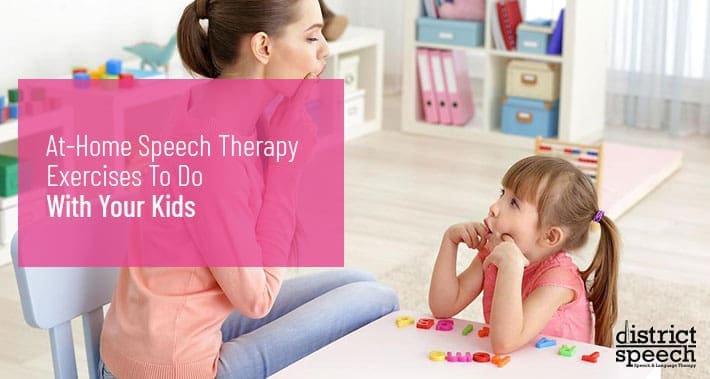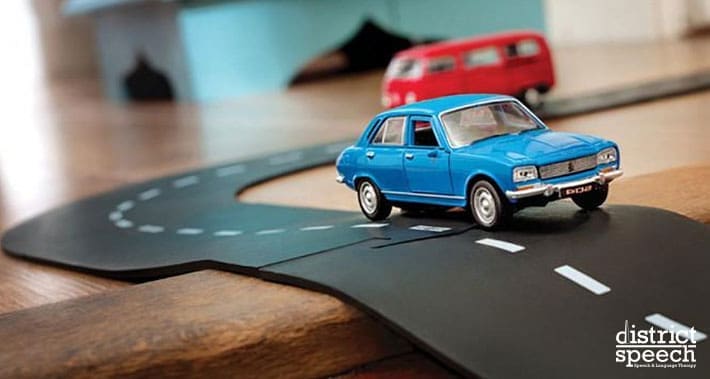
During the height of COVID-19, school children across the country had to transition from traditional in person classes to strictly online learning.
When it comes to childhood education, online learning boasts several unique advantages.
For instance, online learning helps your child develop valuable digital and information technology skills.
Additionally, it can help parents and extended family members feel more included in their child’s learning journey.
However, these advantages can sometimes come at a cost.
For example, many children struggle to pay attention when learning from home.
And while we do offer speech therapy treatments for ADHD, it’s not always related to that.
Here at District Speech, we know all too well the challenges of making sure that your kids are getting the education they need when they can’t be in school.
We also know that it can be difficult to keep them motivated while they’re stuck at home.
In fact, this 2020 research study lists student lack of interest and motivation as one of the major challenges for online learning amongst the COVID-19 pandemic.
There’s a lot of methods you can use to help spark your child’s interest in at home learning, but what if you could help them build their vocabulary as they play?
Here at District Speech, we’ve devised some fun speech therapy for kids that you can do with your children at home.
If you’d like to know more about pediatric speech therapy, we also offer speech teletherapy so that we can help guide you through speech therapy exercises remotely.
In the meantime, check out these ways to turn playtime into speech therapy exercises, and have so much fun they won’t even realize that they’re learning.
1. Reuse Your Plastic Easter Eggs
Remember those old holiday decorations you have stuffed in a closet?
Why not make use of them?
Easter might seem like it was months and months ago, but there’s still more you can get out of it.
The great thing about plastic Easter eggs is that they’re extremely versatile when it comes to arts and crafts.
If you still have small plastic Easter eggs at home, you can use them to develop your kids’ verbal routines.
You can help them associate phrases to meaning.
For instance, shaking the egg while repeating “shake, shake, shake” helps your child associated the word “shake” with its meaning.
You can also open the egg while repeating “open, open, open”.
Then, give them a chance to play and encourage them to say “shake” and “open” as they explore the egg.
You can also try “knock, knock, knock… open” while getting your children to try knocking on the egg.
Encourage your kids to ask questions about where things are when they are hidden in the egg.
This is a great chance to practice prepositions.
Eggs are also a great way to teach your kids to recognize when to say “hello” and “goodbye.”
Try putting toys in and out of the eggs while waving and saying “hello” and “goodbye” as you open and close the egg.
Haven’t got any leftover Easter eggs?
No problem.
You can still practice prepositions and other language skills with your child using speech and language phone apps, such as Splingo’s Language Universe and Articulation Station.
2. Practice Your Verbs With Play Doh
Play Doh has been one of the most popular kid toys for generations.
One of the reasons kids love it so much is its versatility.
From making fun sculptures and new shapes to rolling it between your palms to create colorful little snakes – Play Doh can keep your child busy for hours.
At District Speech, we like to recommend yet another use for Play Doh: speech and language skill development.
Many people don’t realize that Play Doh can double as a learning tool for speech therapy.
However, Play Doh is a common speech language pathology tool for children.
For example, consider asking your kids to make things with Play Doh, and then ask them to explain how they did it in sequence, as though they are teaching you.
This exercise can be particularly helpful for children diagnosed with a speech disorder, such as childhood apraxia of speech or stuttering.
RELATED: What Is Stuttering And How Can A Speech Therapist Help?
Sculptures aren’t the only thing you can build with Play Doh.
It’s also a great tool in building your child’s vocabulary.
Take the chance to introduce them to verbs relating to fabrication, such as close, cut, push, open, roll, smash, squeeze and take out.

3. Play With Toy Cars
Toy cars are another classic kid’s toy that can be incorporated into your kids’ at home speech therapy.
When your kids play with toy cars, they can learn how to follow directions – both spatially and in terms of instructions.
If your kids have a track, even better.
You can build a race track or road together by telling them which pieces to add, and when.
If you don’t have a race track, you can use household objects to come up with a route.
It might go around a chair leg and under a table, for example.
Or, you can take the fun outdoors and use sidewalk chalk to design your very own race track.
RELATED: Kid’s Speech Therapy Exercises You Can Do With Sidewalk Chalk
Your – and their – imagination is the limit.
4. Play The Board Game “Guess Who?”
“Guess Who?” is a popular children’s game that gets you to ask a variety of questions in order to determine your opponent’s card.
It’s all about describing the appearance of people.
When playing the game, kids can get used to identifying different facial features and describing people from a wide range of backgrounds.
In the process, your kids get to practice their articulation skills in a fun way.
Structured games like this also provide the opportunity for children to understand the importance of rules and turn-taking, as well as their language skills.
5. Play With Blocks
Using building blocks can support symbolic play, which is the ability to understand that one object represents another.
For example, your kids might stack bricks and say that it’s a mountain, or stack two bricks and say it represents a house.
Encourage your children to be imaginative and to build fantasy worlds, or scenes where there are a lot of things to see.
You can even encourage them to build the people and places they read about during story time.
RELATED: The Benefits Of Reading To Your Child
You can add to the fun by including some of their regular toys in with their blocks.
They’ll be building houses for the teddy bears to live in no time.
Book An Appointment With District Speech
Speech is an important stage of development and we don’t want any child to miss out when they’re at home.
These exercises are only some of the ways that you can support your kids’ speech and language development from home.
There are many more different types of games and toys that promote articulation and other speech and language skills.
Even Mr. Potato Head can help!
If you’d like to make the most out of your playtime opportunities with your children and you would like help keeping them educated and entertained, book an appointment with District Speech.
Our speech therapists are experienced in working with children and building speech capabilities.
During your first appointment, you and your speech therapist will chat about what you’d like your kids to work on most, and the specific challenges you’re facing.
From there, we’ll come up with ideas that work for you and your family to keep your kids on track with their speech and language abilities.
Book your appointment with District Speech today.
1300 I St NW, Suite 400 E,
Washington, DC 20005
- https://g.page/districtspeech
District Speech and Language Therapy specializes in speech therapy, physical therapy, and occupational therapy solutions, for both children and adults, in the Washington D.C and the Arlington Virginia areas.